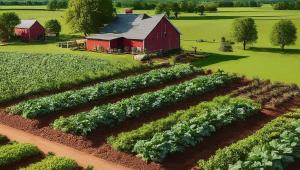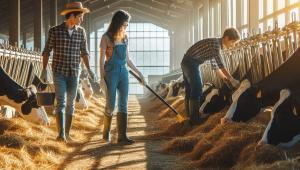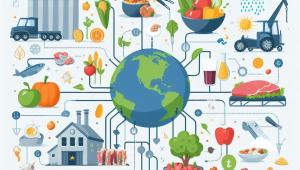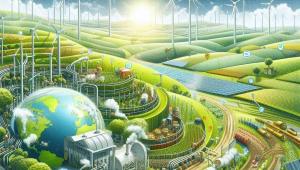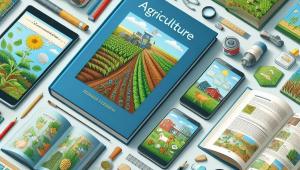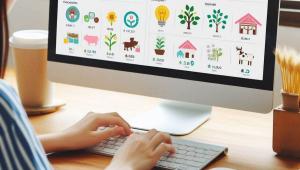Market and economics play a crucial role in the agriculture sector, influencing the production, distribution, and consumption of agricultural products. From the decisions made by individual farmers to the policies implemented by governments, economic principles, and market forces shape the way agriculture operates and contributes to the broader economy.
Basic Economic Concepts in Agriculture
To understand the market and economics of agriculture, it is important to first grasp the basic economic concepts that apply to this sector. These concepts provide a foundation for analyzing the behavior of producers, consumers, and other actors in the agricultural economy.
Supply and Demand
The fundamental economic concept of supply and demand is central to understanding agricultural markets. Supply refers to the quantity of a good or service that producers are willing and able to offer for sale at various prices, while demand refers to the quantity of a good or service that consumers are willing and able to purchase at various prices.
In agriculture, the supply of a particular crop or livestock product is determined by factors such as the number of producers, the productivity of the land or animals, the cost of inputs (e.g., seeds, fertilizers, feed), and weather conditions. The demand for agricultural products is influenced by factors such as population growth, income levels, consumer preferences, and the availability of substitute products.
The interaction of supply and demand determines the market price for agricultural products. When supply exceeds demand, prices tend to fall, while when demand exceeds supply, prices tend to rise. This dynamic plays out in various ways across different agricultural markets and time horizons.
Elasticity
Elasticity is another important economic concept in agriculture, referring to the responsiveness of supply or demand to changes in price or other factors. Elasticity measures how much the quantity supplied or demanded changes in response to a given change in price or income.
In agriculture, the elasticity of supply and demand varies depending on the specific product and market conditions. For example, the demand for staple foods like rice or wheat tends to be relatively inelastic, meaning that price changes have little effect on the quantity demanded, as these products are considered necessities. On the other hand, the demand for luxury or discretionary foods like specialty cheeses or organic produce tends to be more elastic, meaning that price changes have a larger effect on the quantity demanded.
Understanding elasticity is important for agricultural producers, as it can help them make informed decisions about pricing, production, and marketing strategies. It is also important for policymakers, as it can inform the design and implementation of agricultural policies and programs.
Opportunity Cost
Opportunity cost is the value of the next best alternative foregone when a decision is made. In agriculture, opportunity cost is relevant in various contexts, such as land use decisions, crop selection, and resource allocation.
For example, when a farmer decides to grow corn on a particular plot of land, the opportunity cost is the value of the next best alternative use of that land, such as growing soybeans or leaving it fallow. Similarly, when a farmer decides to invest in a new irrigation system, the opportunity cost is the value of other potential investments or uses of those funds, such as purchasing new equipment or expanding the farm's operations.
Understanding opportunity cost is important for agricultural producers, as it can help them make more informed and efficient decisions about how to allocate their limited resources. It is also important for policymakers, as it can inform the design and implementation of policies and programs that incentivize certain agricultural practices or land uses.
Agricultural Production Economics
Agricultural production economics is the study of how farmers and other agricultural producers make decisions about what to produce, how to produce it, and how much to produce, given the available resources and market conditions. It involves the application of economic principles and tools to optimize the use of inputs (e.g., land, labor, capital) and maximize the output and profitability of agricultural production.
Production Functions
A production function is a mathematical representation of the relationship between the quantity of inputs used and the quantity of output produced. In agriculture, production functions can be used to analyze the productivity and efficiency of different crop or livestock systems, as well as to identify the optimal combination of inputs for a given level of output.
For example, a production function for corn might show the relationship between the quantity of fertilizer applied and the resulting yield of corn per acre. By analyzing this relationship, a farmer can determine the optimal amount of fertilizer to use to maximize yield and profitability, given the costs of fertilizer and the market price of corn.
Production functions can also be used to compare the performance of different agricultural technologies or practices, such as conventional versus organic farming, or rainfed versus irrigated cropping systems. This can inform decisions about which technologies or practices to adopt, based on their relative productivity and profitability.
Economies of Scale
Economies of scale refer to the cost advantages that agricultural producers can achieve by increasing the scale of their operations. As the size of a farm or ranch increases, the fixed costs of production (e.g., land, buildings, equipment) can be spread over a larger output, reducing the average cost per unit of output.
In agriculture, economies of scale can be achieved through various means, such as:
- Specialization: By focusing on a particular crop or livestock product, producers can become more efficient and reduce costs through specialized knowledge, skills, and equipment.
- Mechanization: By adopting labor-saving technologies such as tractors, combines, and milking machines, producers can increase the scale of their operations and reduce labor costs.
- Vertical integration: By integrating different stages of the supply chain, such as production, processing, and distribution, producers can achieve economies of scale and reduce transaction costs.
However, economies of scale in agriculture also have limitations and potential drawbacks, such as:
- Environmental impacts: Large-scale, intensive agricultural operations can have negative impacts on soil health, water quality, and biodiversity, as well as contribute to greenhouse gas emissions.
- Social impacts: The consolidation of agricultural production into fewer, larger farms can lead to the displacement of small-scale farmers and the decline of rural communities.
- Market power: Large-scale producers may have greater market power and the ability to influence prices, which can lead to anti-competitive practices and reduced choices for consumers.
Understanding economies of scale is important for agricultural producers, as it can inform decisions about the optimal size and scale of their operations, as well as the potential trade-offs between efficiency and sustainability. It is also important for policymakers, as it can inform the design and implementation of policies and programs that support different types and scales of agricultural production.
Risk and Uncertainty
Risk and uncertainty are inherent in agricultural production, due to factors such as weather variability, pest and disease outbreaks, and market volatility. Agricultural producers must make decisions about what to produce, how to produce it, and how much to produce, in the face of these uncertainties.
There are various types of risks in agriculture, including:
- Production risk: The risk of yield or quality losses due to factors such as drought, flooding, or pest damage.
- Price risk: The risk of fluctuations in the market prices of agricultural inputs and outputs, which can affect the profitability of production.
- Financial risk: The risk of financial losses due to factors such as high debt levels, interest rate changes, or cash flow problems.
- Institutional risk: The risk of changes in government policies, regulations, or programs that affect agricultural production and markets.
To manage risk and uncertainty in agriculture, producers can use various strategies, such as:
- Diversification: By producing a variety of crops or livestock products, producers can reduce their exposure to production and price risks in any one market.
- Insurance: By purchasing crop insurance or other types of insurance, producers can protect themselves against yield or revenue losses due to weather or other factors.
- Hedging: By using futures contracts or other financial instruments, producers can lock in prices for their products in advance, reducing their exposure to price risk.
- Vertical coordination: By entering into contracts or other arrangements with buyers or processors, producers can reduce their exposure to market risks and ensure a stable outlet for their products.
Understanding risk and uncertainty is important for agricultural producers, as it can inform their decisions about production, marketing, and risk management strategies. It is also important for policymakers, as it can inform the design and implementation of policies and programs that help mitigate risk and support the resilience of agricultural systems.
Agricultural Marketing and Trade
Agricultural marketing and trade involve the distribution and exchange of agricultural products from producers to consumers, both within and across countries. It encompasses the various activities and actors involved in the supply chain, including transportation, storage, processing, wholesaling, and retailing, as well as the policies and institutions that govern these activities.
Marketing Channels and Value Chains
Marketing channels refer to the various routes and intermediaries through which agricultural products move from producers to consumers. These can include direct marketing channels, such as farmers markets or community-supported agriculture (CSA) programs, as well as indirect channels, such as wholesalers, processors, and retailers.
Value chains refer to the sequence of value-adding activities and actors involved in bringing a product from its initial production to its final consumption. In agriculture, value chains can be complex and diverse, involving multiple stages of processing, packaging, and distribution, as well as a range of actors such as input suppliers, farmers, traders, processors, and retailers.
Understanding marketing channels and value chains is important for agricultural producers, as it can inform their decisions about where and how to sell their products, as well as how to capture more value from their production. It is also important for policymakers, as it can inform the design and implementation of policies and programs that support the development of efficient, inclusive, and sustainable agricultural markets and value chains.
International Trade and Comparative Advantage
International trade plays a significant role in the global agricultural economy, with many countries exporting and importing agricultural products. The patterns and impacts of agricultural trade are shaped by various factors, including differences in resource endowments, production costs, and consumer preferences across countries, as well as trade policies and agreements.
The principle of comparative advantage suggests that countries should specialize in producing and exporting the goods and services for which they have a relative cost advantage, and import the goods and services for which they have a relative cost disadvantage. In agriculture, comparative advantage can be based on factors such as land and water availability, climate suitability, labor costs, and technological capabilities.
For example, countries with abundant land and favorable climates, such as Brazil and the United States, may have a comparative advantage in producing and exporting land-intensive crops like soybeans and corn, while countries with limited land and high labor costs, such as Japan and South Korea, may have a comparative advantage in producing and exporting high-value, labor-intensive crops like fruits and vegetables.
However, the actual patterns of agricultural trade are also influenced by various policies and institutions, such as tariffs, subsidies, and trade agreements, which can distort market signals and create trade barriers. These policies and institutions can have significant impacts on the competitiveness and welfare of agricultural producers and consumers, both within and across countries.
Understanding international trade and comparative advantage is important for agricultural producers, as it can inform their decisions about which products to produce and which markets to target, based on their relative strengths and weaknesses. It is also important for policymakers, as it can inform the design and implementation of trade policies and agreements that promote fair and efficient agricultural trade, while also supporting domestic policy objectives such as food security and rural development.
Price Determination and Market Structure
The prices of agricultural products are determined by the interaction of supply and demand in various markets, from local to global scales. The factors that influence supply and demand, and hence prices, can vary depending on the specific product and market but generally include:
- Production costs: The costs of inputs such as land, labor, capital, and materials, affect the profitability and hence the supply of agricultural products.
- Consumer preferences: The tastes, values, and incomes of consumers, affect the demand for different types and qualities of agricultural products.
- Market structure: The number and size of buyers and sellers in a market, as well as the degree of product differentiation and barriers to entry, which affect the level of competition and market power.
- Government policies: The various policies and programs that affect the production, trade, and consumption of agricultural products, such as subsidies, tariffs, and regulations.
The structure of agricultural markets can range from perfectly competitive, with many small buyers and sellers and homogeneous products, to oligopolistic or monopolistic, with a few large buyers or sellers and differentiated products. The degree of market power and concentration can have significant impacts on the prices, quantities, and quality of agricultural products, as well as the distribution of benefits and costs along the value chain.
For example, in a perfectly competitive market for a commodity like wheat, individual farmers are price takers and have little control over the market price, which is determined by the aggregate supply and demand for wheat. In contrast, in an oligopolistic market for a differentiated product like branded coffee, a few large buyers or sellers may have significant market power and the ability to influence prices and quality standards, which can affect the bargaining power and welfare of small-scale producers.
Understanding price determination and market structure is important for agricultural producers, as it can inform their decisions about what to produce, how to produce it, and how to market and sell their products, based on the prevailing market conditions and their competitive position. It is also important for policymakers, as it can inform the design and implementation of policies and programs that promote fair and efficient agricultural markets, while also addressing issues of market failure, equity, and sustainability.
Agricultural Policy and Economics
Agricultural policy refers to the various laws, regulations, and programs that governments use to influence the production, distribution, and consumption of agricultural products, as well as the broader economic, social, and environmental outcomes of the agricultural sector. Agricultural economics provides the analytical tools and frameworks for evaluating the impacts and effectiveness of these policies, as well as for designing and implementing policies that support specific policy objectives.
Policy Objectives and Instruments
Agricultural policies can have a wide range of objectives, depending on the specific context and priorities of a country or region. Some common policy objectives in agriculture include:
- Food security: Ensuring an adequate and stable supply of safe and nutritious food for the population, particularly for vulnerable and low-income groups.
- Income support: Providing financial assistance to agricultural producers to stabilize their incomes and support their livelihoods, particularly in the face of market volatility and production risks.
- Environmental sustainability: Promoting agricultural practices and technologies that conserve natural resources, protect biodiversity, and mitigate and adapt to climate change.
- Rural development: Supporting the economic and social well-being of rural communities, through investments in infrastructure, education, health, and other services.
- Trade and competitiveness: Enhancing the competitiveness and market access of domestic agricultural products, while also ensuring a level playing field for domestic producers vis-à-vis foreign competitors.
To achieve these objectives, governments can use a range of policy instruments, such as:
- Price supports: Setting minimum prices or providing direct payments to producers to ensure a stable and adequate income.
- Supply controls: Limiting the production or marketing of certain agricultural products to manage supply and stabilize prices.
- Trade measures: Using tariffs, quotas, or other trade barriers to protect domestic producers from foreign competition, or to promote exports of domestic products.
- Environmental regulations: Setting standards or providing incentives for agricultural practices that reduce environmental impacts or provide ecosystem services.
- Research and extension: Investing in research and development of new agricultural technologies and practices, and providing extension services to disseminate knowledge and skills to farmers.
Designing and implementing effective agricultural policies requires careful consideration of the trade-offs and synergies among different policy objectives and instruments, as well as the distributional impacts on different groups of producers and consumers. This is where agricultural economics can play a key role, by providing the analytical tools and evidence base for evaluating the costs, benefits, and risks of different policy options.
Market Failure and Government Intervention
One of the key rationales for government intervention in agricultural markets is the presence of market failures, which occur when the market fails to allocate resources efficiently or equitably, due to factors such as externalities, public goods, information asymmetries, or market power.
Some examples of market failures in agriculture include:
- Environmental externalities: Agricultural production can have negative impacts on the environment, such as soil erosion, water pollution, and greenhouse gas emissions, which are not fully reflected in market prices and can lead to overproduction and resource degradation.
- Public goods: Some agricultural activities, such as research and development, extension, and conservation, have public good characteristics, meaning that they provide benefits to society as a whole but may be undersupplied by the private sector due to free-rider problems.
- Information asymmetries: Agricultural producers and consumers may have incomplete or asymmetric information about the quality, safety, or environmental attributes of agricultural products, which can lead to adverse selection and moral hazard problems.
- Market power: Agricultural markets may be characterized by a high degree of concentration and market power, particularly in the input and processing sectors, which can lead to inefficient and inequitable outcomes for producers and consumers.
In the presence of market failures, government intervention may be justified to correct the market failures and improve the efficiency and equity of agricultural markets. However, government intervention can also have its costs and risks, such as distorting market signals, creating perverse incentives, or favoring certain groups over others. Therefore, the design and implementation of agricultural policies need to carefully balance the benefits and costs of intervention, and ensure that the policies are transparent, accountable, and responsive to the needs and priorities of different stakeholders.
Policy Analysis and Evaluation
Agricultural policy analysis and evaluation involve the use of economic theories, methods, and data to assess the impacts and effectiveness of existing or proposed agricultural policies, as well as to identify the winners and losers of these policies.
Some common approaches to agricultural policy analysis and evaluation include:
- Partial equilibrium analysis: Examining the impacts of a policy on a specific market or sector, holding all other factors constant, using supply and demand models and welfare analysis.
- General equilibrium analysis: Examining the economy-wide impacts of a policy, taking into account the interactions and feedback effects among different markets and sectors, using input-output models or computable general equilibrium (CGE) models.
- Cost-benefit analysis: Comparing the monetary and non-monetary costs and benefits of a policy, from the perspective of different stakeholders or society as a whole, using discounting and sensitivity analysis.
- Econometric analysis: Using statistical methods to estimate the causal effects of a policy on specific outcome variables, such as prices, production, or income, using observational or experimental data.
- Stakeholder analysis: Assessing the interests, influence, and impacts of a policy on different groups of stakeholders, such as producers, consumers, traders, or policymakers, using qualitative or quantitative methods.
The results of agricultural policy analysis and evaluation can inform the design, implementation, and reform of agricultural policies, by providing evidence on what works, what doesn't, and for whom. They can also facilitate public debate and dialogue on the goals, priorities, and trade-offs of agricultural policies, and promote accountability and learning in the policy process.
However, agricultural policy analysis and evaluation also face several challenges and limitations, such as:
- Data availability and quality: Agricultural data, particularly in developing countries, may be scarce, incomplete, or unreliable, which can limit the scope and robustness of policy analysis.
- Complexity and uncertainty: Agricultural systems are complex and dynamic, with multiple interacting factors and feedback loops, which can make it difficult to predict and measure the impacts of policies.
- Political economy: Agricultural policies are shaped by the interests, incentives, and power relations of different actors and institutions, which can create barriers to evidence-based policymaking and reform.
- Equity and inclusion: Agricultural policies can have differential impacts on different groups, such as small-scale farmers, women, or indigenous peoples, which may require specific attention and engagement in the policy process.
Therefore, effective agricultural policy analysis and evaluation require not only technical skills and tools but also an understanding of the political economy and institutional context of agricultural policymaking, as well as the principles of participatory and inclusive policy processes.
Conclusion
Market and economics play a crucial role in shaping the performance and outcomes of the agricultural sector, from the decisions of individual farmers to the policies of national and international institutions. By understanding the basic economic concepts, production economics, marketing and trade, and policy and economics of agriculture, we can better analyze the challenges and opportunities facing the sector, and design and implement strategies and policies that support sustainable, efficient, and equitable agricultural development.
Some key insights and implications from this analysis include:
- Agricultural production and markets are subject to various risks and uncertainties, such as weather, pests, and price volatility, which require effective risk management strategies and policies, such as insurance, diversification, and safety nets.
- Agricultural markets are characterized by various forms of market failure, such as externalities, public goods, and market power, which may require government intervention to correct, while also recognizing the potential costs and risks of intervention.
- Agricultural trade and global value chains offer opportunities for specialization, efficiency, and growth, but also pose challenges for equity, sustainability, and resilience, which require policies and institutions that balance these objectives.
- Agricultural policies have multiple objectives and instruments, which can have synergies and trade-offs, and differential impacts on different groups, which require evidence-based, participatory, and adaptive policy processes.
- Agricultural economics provides valuable tools and frameworks for analyzing the market and policy dimensions of agriculture but also needs to engage with other disciplines and stakeholders to address the complex and context-specific challenges facing the sector.
As we look to the future, the agricultural sector will continue to face significant challenges and opportunities, driven by factors such as population growth, climate change, technological innovation, and changing consumer preferences. To meet these challenges and opportunities, we will need to harness the power of markets and economics, while also recognizing their limitations and the need for inclusive, equitable, and sustainable approaches to agricultural development.
This will require a renewed commitment to investing in agricultural research, innovation, and education, as well as in the institutions and policies that enable farmers, agribusinesses, and consumers to participate in and benefit from agricultural markets and value chains. It will also require a greater emphasis on collaboration, partnership, and dialogue among different stakeholders, to co-create and co-implement solutions that are locally relevant, globally-connected, and future-oriented.
Ultimately, the goal of the agricultural market and economics should be to contribute to the broader vision of a world where everyone has access to sufficient, safe, and nutritious food, produced in a way that is economically viable, socially equitable, and environmentally sustainable. By understanding and leveraging the principles and tools of market and economics, while also recognizing their limitations and the need for a holistic and inclusive approach, we can work towards this vision and build a more resilient, prosperous, and sustainable agricultural sector for all.
